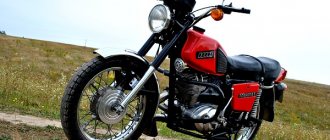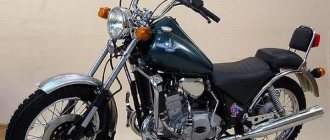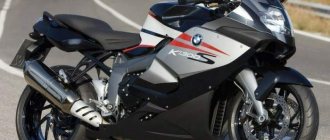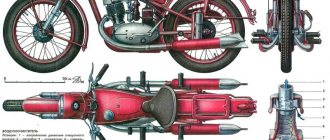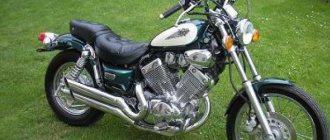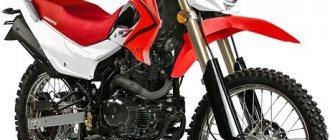Story
The IZH Jupiter-4 road motorcycle was produced by the Izhevsk engineering plant from 1980 to 1985. In the production race, the engineering company decided to increase the maximum speed of the motorcycle by upgrading the engine. It is not surprising that the production of the Czech Jawa did not suffer any losses.
At that time, Jawa was Izhey’s main competitor. The elegant Czech motorcycle was superior to the Jupiter with a more sophisticated design. Czech engineers have created a faster, more economical and, most importantly, reliable two-wheeled vehicle. Despite this, the domestic IZH was in considerable demand within the country. Over five years of production, more than a million copies of IZH Jupiter-4 and IZH Jupiter-4k were produced and sold. The latter is distinguished by the presence of a side trailer (stroller). After 1985, a new series of domestic motorcycles, IZH Jupiter-5, was launched into production.
It was the summer of 2014 when I wanted to add a new motorcycle to my garage. I settled on the Jupiter-4 motorcycle because I had an IZH-Planet 4 and wanted to have 2 IZHs of the fourth model. I looked for a motorcycle with documents for a long time and for a long time could not find anything. And suddenly, I found an advertisement for the sale of an IZH-Y4 motorcycle with documents. This motorcycle was 15 km from my house and I went to look at it. What I saw shocked me a little, since there was almost no smell of a motorcycle there. There was a frame, a dubious lining and a badly made steering wheel; the craftsmen also cut up the original leather seat to make a café out of it. In general, we agreed on an exchange. I brought in Planet 3 without documents in average condition and in exchange for this I received Jupiter 4 and Jupiter 5. The engines of both were gutted, both engines from Jupiter 5, and I wanted to make the original. This is how I brought him home.
Then the search for original parts began. Facing, small things and most importantly - the engine! All the cladding was found, everything was ready for painting. I decided to choose an orange color, otherwise the city is full of negativity because of black, white, gray colors, I wanted something bright! And now, the cladding is ready.
Winter was approaching, and the wiring was found. While disassembling, I found 2 sets of original wiring from Jupiter and took them all home. I didn’t have much time, since on weekdays I studied at the university in the city, and was only at home on weekends. But over the weekend, with the house warm, the wiring was slightly assembled.
Everything was worse with the engine... It was half assembled, but there was difficulty in finding the original cylinders. This problem seriously got in the way. But one day I saw an advertisement for the sale of a liquid-cooled engine. The engine was 30 km away from me and I decided to pick it up. So, I brought the engine, but I was shocked... It was completely frozen! The guys who invested in it filled the system with water and left the motorcycle outside for the winter. The new piston immediately rusted... And then we realized that we couldn’t revive it so easily. There was antifreeze and oil in the crankcase, and there were also traces of unskilled repairs. It was quite a sight... Here is a photo from the arrival of the new engine.
The engine was successfully overhauled. So, a new factory piston, almost everything assembled from scratch. It was almost March and we tried to start this miracle. After 2 days of fine-tuning the wiring, it came to life! The engine has started! But the sound was not clear, the ignition and carburetor were not properly adjusted, something was not properly tightened. But the main thing is that he came to life! This made us very happy!
And now - the motorcycle is ready! New, fresh, refurbished inside and out. We gave it a second life, replaced its heart with a more modern version, since I used it almost the entire season in the city and in traffic jams. Liquid cooling came in handy here. The time has come to register the motorcycle in your name, but... A problem has arisen. This motorcycle was bought from the current owner by certain individuals, then resold without re-registration to others, and so on again. In general, the motorcycle passed through hands for 2 years and changed at least 3 owners, who did nothing with it, but only finished it off. I met with the owner and explained the situation, he understood everything and we re-issued the policy. And yes, the previous guys received a lot of fines on this IZh and they were paid for by the old owner. This is how he went to registration.
It's finally officially mine! Test runs and fine-tuning began. The BPV was replaced, the shorted light switches were replaced, the ignition cams were replaced with factory ones, the carburetor was humanly adjusted. The original front fender was also found, the front fork was completely rebuilt and after these procedures absolutely everything in the motorcycle was rebuilt from start to finish. This is what he became after all the long work on him.
And so my motorcycle season began. When I defended my diploma, I finally had time for riding. Then every day I went to the city on an IZhe, passers-by were surprised when they saw such a motorcycle in the city. I went to festivals with a friend and got tested. At one of the motorcycle events, the motorcycle was even shown on the news, it was something! And so, the revived IZH-Jupiter 4 began its new story... At the end of this short story there are a few photos from the past motorcycle season.
PS And this is not the last IZH motorcycle that will get a second wind... Another one is already being assembled - Planet 5-01. More on this later) Thanks for your attention)
Technical characteristics, recommendations
Let's look at the qualitative data of the IZH Jupiter-4 motorcycle. Its characteristics are as follows:
- engine power – 28 hp. With.;
- maximum speed – 130 km/h;
- weight – 160 kilograms (with equipment);
- maximum engine speed – 7800 rpm;
- ground clearance - 130 mm;
- Gearbox 4-speed, semi-automatic;
- multi-plate clutch system in an oil bath;
- fuel type - air-gasoline mixture (Au - 76, Au - 80 together with oil);
- two-cylinder carburetor two-stroke.
Since the IZH Jupiter-4 ignition has a cam, it is important to set it up reliably and occasionally inspect it. The process of setting the timing of the spark is described below. It is important that the generator armature is installed level and that the bolt that attaches it to the crankshaft is tightened tightly.
From time to time it doesn't hurt to inspect the ignition elements. Soviet engineers did not provide for the machine to operate uninterruptedly in the presence of water or humidity. Therefore, if problems arise with the spark, you need to inspect the ignition contacts for oxidation.
It would not hurt to carry out similar procedures with other electrical systems and contacts.
Five random articles about motorcycles:
Development of a two-stroke motorcycle engine (Java 634)
Found power The magazine has already talked a lot about the operation of a motorcycle - about the care of electrical equipment, wheel balancing, and fuel consumption. This article is devoted to fine-tuning a two-stroke motorcycle engine. Many motorcyclists believe that to restore the engine's former power, it is enough to replace worn parts with new ones and carefully break in the car.
This usually happens, but often, after completing the repair, they note with bewilderment its low efficiency and, having unsuccessfully tested various adjustment options, they conclude that it is impossible to get more from this engine. In fact, if all other systems are in good working order, very often it is possible to significantly increase the main parameters (power, throttle response, efficiency) of such a motor by fine-tuning, or rather, mutual adjustment of some of its parts. The fact is that, due to the requirements of mass production, As is the motorcycle industry, some sizes of parts, especially those produced by casting, have a fairly significant spread. EU... Read more >>
How Czechoslovakian mechanical engineers take into account the proposals of Java motorcycle owners from the USSR
There is only one goal - quality. At the end of 1984, YAVA-350 motorcycles of the model “638-5-00” began to arrive in our stores (see “Behind the wheel”, 1986, No. 3), which differed from its predecessor - “634.00” mainly in the engine and electrical equipment (12 instead of 6 V), as well as a front fork.
Owners of new cars positively assessed the improvements. At the same time, they expressed wishes regarding the manufacture of certain components, especially engine parts. Czechoslovak specialists - technologists, designers, having analyzed letters from consumers from the USSR, implemented a set of measures that take into account their suggestions. This work was completed last fall. And recently the scientific editor of the magazine, engineer B. SINELNY KOV, visited Czechoslovakia and got acquainted with the production of motorcycles at Czechoslovak factories. There is probably no need to talk about the great popularity of the JAVA and ChZ motorcycles, which have been attracting our motorcyclists for thirty years with their chassis... Read more >>
CZ 988 Touring motorcycle
Read more >>
A journey of half a century. IZH-7, IZH-D, IZH-9, IZH-350, IZH-49, IZH-56, IZH-Planet-4, IZH-Jupiter-4
IZH-7, IZH-D, IZH-9, IZH-350, IZH-49, IZH-56, IZH-Planet, IZH-Jupiter On the outskirts of Izhevsk there is a monument - motorcyclists on rearing cars.
It symbolizes the successes of city workers in the production of motorcycles and in the development of motorsports. Half a century ago, in accordance with the decision of the People's Commissariat of Heavy Industry, motorcycle production was organized here in Izhevsk on the basis of the experimental workshops of Izhstalzavod. Even earlier, in 1928, in these workshops, a group of enthusiasts under the leadership of engineer P.V. Mozharov designed and built prototypes of machines. However, due to the lack of production capabilities, it was not possible to launch serial production of motorcycles. Izhevsk residents began producing them in 1933. Between the two models you see in the pictures, there is a journey of half a century. We started with the IZH-7 motorcycle, which differed only in details from the simple L-300 machine with a two-stroke engine, which had been mastered by that time in Leningrad and Ural. Until the end of last year, inertia-oil type filters were used, in the housing of which there is an oil bath and a filter element in the form of padding made of synthetic fibers. Such filters have a relatively low air purification efficiency and require frequent maintenance, primarily topping up and changing the oil, as well as washing the packing. Dry type filters, in which the filter element is special porous paper or non-woven material, are more effective. They have high cleaning efficiency (99.3-99.9%) and require less maintenance. A new air filter with a paper element has been developed and extensively tested at the Kiev Motorcycle Plant, which has been installing since the end of last year... Read more >>
login registration forgot your password?
Motorcycle goods store About the store Terms and return procedure
The difference between Jupiter IZH-4 and its predecessor, IZH Yu3
Actually, the “fourth” is considered the most successful and reliable among the Jupiter generation. It differs from its predecessor, IZH Jupiter-3, in having a more powerful power unit (the power of IZH Jupiter-4 is 28 horsepower, while Jupiter-3 produces only 25). Engineers managed to increase engine power due to a new cylinder design. In the new cylinders, the designers provided wider purge windows. Due to this, the maximum crankshaft speed has increased (7800 rpm).
But, unfortunately, in the pursuit of money, the plant overlooked the issue of quality and reliability of the design. Years later, IZH Jupiter-4 showed its weaknesses. Namely, the design of the cylinders did not provide for higher strength and reliability. The engine life has been significantly reduced due to the increase in purge windows.
In addition to modernizing the cylinder-piston group, Izhmash specialists provided modern 12-volt electrical equipment for the new Jupiter model. This modernization gave the IZH Yu-4 a brighter light and a more powerful ignition spark compared to the 6-volt previous models.
Three modifications of the IZH Planet 5 motorcycle
For many years, the Izhmash Association has been pursuing a policy of broad unification of manufactured machines. Not only parallel, that is, for models produced simultaneously, for example, “IZH-Jupiter-5” and “IZH-Planeta-5”, but also sequential - the continuity of later machines with their predecessors (“IZH-Planet-5”, “IZH-Planet-5”) Planet-4", "IZH-Planet-3", etc.). This trend will continue in the near future. As is known, Izhmash designers envision three promising families of motorcycles: “Sirius” to replace the “Planet”, “Saturn” to replace the “Jupiter” and the new “Orion” family (ZR, 1990, No. 6). The latter is based on a Japanese license, covering a four-stroke single-cylinder engine, telescopic front forks, front disc brake, cast light alloy wheels.
The development of an engine of the Yamaha-X-T-550 type is possible no earlier than 1992, although more optimistic dates have also been mentioned. And production of forks, wheels and brakes, to the delight of motorcyclists, has already begun. Naturally, their design has undergone changes to make it possible to install them on the already produced IZH-Planet-5 model. As production is mastered, Jupiters and then IZH-Orion will be equipped with new units. The editors asked Izhmash deputy chief designer for motorcycle manufacturing V. RUDENKO to talk about the new modifications of Planet-5.
We have mastered, under license, the production of a more modern telescopic front fork with increased wheel travel, as well as a front wheel disc brake and its hydraulic drive, wheels cast from aluminum alloy.
For now, only some of the machines will be equipped with these parts, since, on the one hand, it is not yet possible to provide them with the entire production program, and on the other, the consumer must have a certain choice of motorcycles that differ in design and performance. Let's take a closer look at each of the nodes.
The wheels are cast into a die made of AK9T aluminum alloy. This material allows some deformation of the part, but compared to a traditional wheel with wire spokes, a cast wheel is noticeably stiffer (especially in the lateral direction) and stronger, which is especially important when disc brakes are used, which, compared to drum brakes, create higher loads on the spokes . Cast wheels do not require periodic tightening of the spokes, they are easier to clean from dried dirt, and finally, they have a more attractive appearance.
Izhmash produces cast wheels for both tire sizes 3.25-19 and 3.50-18 inches. Their weight is respectively (without tire and tube) 7.6 and 7.0 kg, while a tangential (spoked) wheel of a traditional design for a tire measuring 3.50-18 inches has a weight of 6.6 kg.
The front wheel disc brake is single-piston with a floating caliper, secured with two bolts to the left tube of the telescopic front fork. The disk with an outer diameter of 300 mm is connected to the wheel hub with six bolts.
The drive is driven by a hydraulic system. Its capacity is 200 cm3; liquid "Tom" or "Neva". On the right handlebar there is a brake master cylinder, combined with a fluid reservoir. The hand brake lever is connected directly to the cylinder. During repeated and frequent braking, a disc brake cools better and maintains its characteristics stable - an important advantage compared to a traditional drum brake. It is especially noticeable when driving on mountain roads or on highways with heavy traffic flow.
Telescopic front fork - spring, pneumohydraulic. It is stiffer than its predecessor due to the outer diameter of the working cylinder increased to 38 mm. In addition, it provides greater wheel travel - up to 200 mm. In this regard, the transition to it can be characterized as a step that helps improve safety and driving comfort.
Depending on road conditions and load, you can change the characteristics of the front wheel suspension. Pneumatic regulation is carried out by pumping air into the cavity of both fork stays using a tire pump. In this case, it is important that the difference in pressure in the right and left does not exceed 0.1 kgf/cm2.
The new fork is only used in combination with a disc brake.
Starting this year, Izhmash produces, in addition to the basic model “Planet-5” (industry designation IZH - 7.107), three modifications of it, depending on the configuration options with new components. Here they are.
IZH 7.107-014 : only cast 18-inch wheels with drum brakes. The dry weight of the motorcycle is 160 kg. For this modification, which should be produced in the amount of 5 thousand cars this year, the retail price is set at 1,085 rubles.
IZH 7.107-015 : new telescopic fork, front wheel disc brake with hydraulic drive, cast wheels: front - 19-inch, rear - 18-inch (see photo). Dry weight - 160 kg. In 1990, 20 thousand motorcycles will be produced in this configuration. Retail price - 1150 rubles. By the way, this is the first production model in the history of the domestic motorcycle industry with disc brakes and cast wheels.
IZH 7.107-016 : new telescopic fork, drum brakes, tangential wheels. Dry weight - 160 kg. The price of the modification is 1060 rubles, the production volume in 1990 was 5 thousand cars.
The remaining components and the engine of three modifications are the same as those of the basic model “IZH-Planet-5” (see ZR, 1987, No. 3 - ed.). The first two modifications are designed for operation without a side trailer.
1990N10P6
About the disadvantages
It is worth noting that among owners of IZH motorcycles, the Jupiter IZH-4 model is not very popular. Experienced users claim that the fourth “Jupiter” is the most unsuccessful model from the entire range of IZH motorcycles. In addition to the fact that the strength of the high-speed engine leaves much to be desired, Jupiter-4 has the following “diseases” and disadvantages:
- constant oil leakage from the engine crankcase;
- “ringing” of fingers after short use;
- short gearbox resource;
- constant problems with the ignition system;
- high fuel consumption;
- lack of monitoring systems for fuel level, engine temperature and oil level in the crankcase;
- out-of-date design;
- Lack of knowledge in the field of operation and repair of this motorcycle can lead to significant material costs for repairing the unit and/or treating the biker.
Most owners of Soviet motorcycles are confident in the above. Particular attention must be paid to the ignition system. In fact, the process of setting the ignition timing does not require phenomenal skills or special knowledge.
Reviews
Reviews of “Jupiter IZH-4” have both positive and negative. Some of the bike owners are confident that if you treat your equipment with care and carry out technical inspections and repairs in a timely manner, the results will not take long to arrive. When purchasing a motorcycle, you can have virtually zero knowledge regarding repair and operation. The main thing is that the Jupiter IZH-4 was purchased either in good condition or was completely renovated. Then many problems and “diseases” of the motorcycle will not bother the driver.
Other owners of this motorcycle consider high engine power and excellent acceleration performance to be positive aspects. If you make a few changes to the design, IZH Jupiter-4 can easily take on a modern, attractive look.
Complaints mainly concern unstable voltage regulator relays, problems with the ignition system and rapid wear of engine elements.
Setting up the IZH Yu-4 ignition
To correctly adjust the ignition timing, you must adhere to the following points:
- Remove the spark plugs from both cylinders.
- Turn the crankshaft using the generator armature bolt (a key size of 11 is suitable) until the breaker contacts open to maximum, which is based on 6.
- Loosen bolt 5 and turn 4, setting the gap to the thickness of a razor blade (or 0.4-0.6 mm, if you have precise measuring instruments).
- Fasten bolt 5 and perform a similar procedure with the upper contact, that is, the left cylinder.
- Use a piston stroke measuring device. If there is none, use a thick rod with a smooth surface that will fit into the spark plug hole.
- Rotate the crankshaft until the right piston reaches top dead center, lower it 2.2-2.6 mm lower by turning the crankshaft counterclockwise.
- Unscrew bolts 2, 3, 7, set the distance between the lower contacts to 0.2-0.6 mm or to the thickness of the blade by turning the eccentric 4.
- Perform a similar procedure with the left cylinder, the ignition of which is determined by the upper contact.
